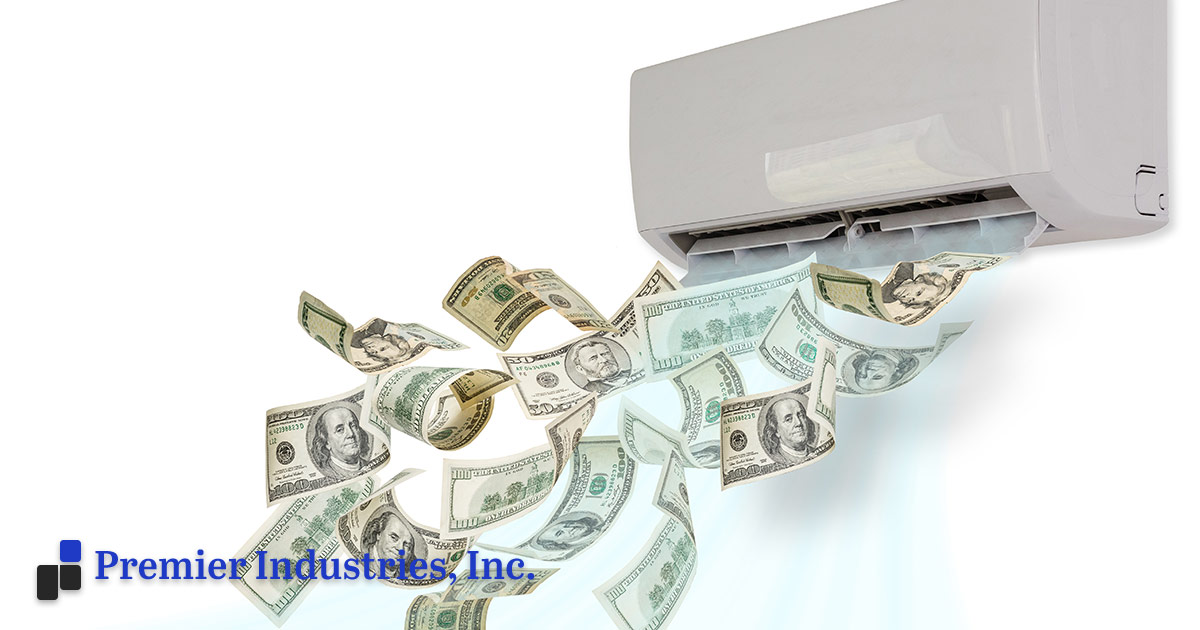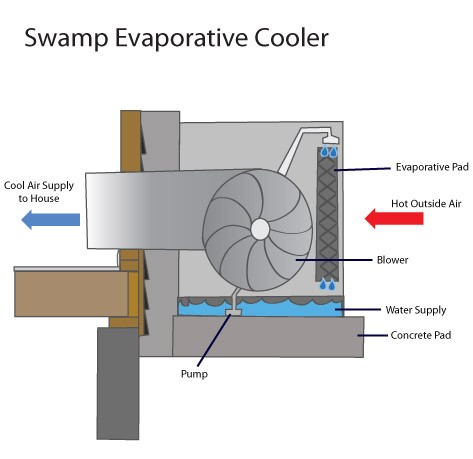
How Much Does it Cost to Run a Swamp Cooler All Day?
August 24, 2020 6:22 pm Leave your thoughtsSwamp coolers are an option for many homeowners. This article will help you understand how they work and costs associated with their operation. Swamp coolers are more often used in states where the weather is drier such as Arizona, Utah and Nevada. But how do they work?
How Swamp Coolers Work
Swamp coolers use a process called evaporative cooling, meaning that it uses moisture to cool the air. It takes warm air, puts it through wet evaporative cooler pads to produce cool air. This air is then circulated through the home by a blower motor and vents. The swamp cooling unit is made up of several main parts: water supply valve, float, pump, evaporative pads and blower. The water supply valve brings water into the unit. When the unit is filled with water, the float comes to the top to cut off the water supply. The pump is responsible for sending the water through the water distribution lines that keep the evaporative pads wet. The evaporative pads clean and cool the air. The blower motor pushes the cooled air throughout the house. Each of these elements play an important role in the operation of a swamp unit. The unit may not function if any part doesn’t work.

How Much Does It Cost to Run an Evaporative Cooler?
While swamp coolers can be used anywhere, they are most often used in dry climates. They are also less expensive than their counterparts. The cost of installing and running a compressor and air handler is significantly more expensive than a swamp cooler.
Some homeowners opt to use a central air conditioning system and a swamp unit. They use the cooler during the hot, dry months and the other unit during rainy, humid seasons. This makes the best use of both systems. Swamp coolers don’t work as well during periods of high humidity. Using the unit whenever possible allows homeowners to save 75% on electricity needed to operate the central air conditioning system. The option to switch between the two systems allows homes to remain cool without needed to operate the central air system continually. This saves money because the central air system is there when needed but when the humid air passes, they can switch back to the swamp unit. The swamp cooler requires far less electricity thereby saving money. For example, if electricity costs $0.15 per Kwh (Kilowatts per hour), it takes $1.13 per hour to operate an A/C system. It’s only $0.26 per hour to run the cooler. That’s real savings.
What’s More Cost-Effective, Running a Swamp Cooler or A/C Unit All Day?
Given that coolers use less energy than a central air conditioning system, they are more economical. As mentioned, many homeowners use both systems depending on the weather conditions.
You should be aware, though that a unit that operates all day will need to be maintained. With a central air conditioning unit, you have to regularly change the air filters. For a cooler, it will need to be regularly drained and cleaned. This prevents minerals and sediment from building up. Assume that you will give the unit a deep clean each season. The more often it runs, the more often it will need to be cleaned. This means cleaning and replacing the evaporative pads at least once a month. So while a colling unit is more cost-effective to operate, the monthly maintenance may be a deal-breaker for some people. Also, if the unit is mounted on the roof, it will need to be accessed by a ladder. This is inconvenient for some people.
Five Tips for Reducing Evaporative Cooling Costs
There are several tips that can help your swamp cooler operate more efficiently.
- Open your windows: Unlike central air conditioning, swamp coolers operate more efficiently when windows are cracked open a small bit. Air is pulled across the room and warm air sent outside.
- Use it during periods of lower humidity: Coolers are not effective when the humidity is about 75%. It can actually make the air feel damp. For some people, this means only using the cooler for part of the year.
- Operate the cooler before turning the blower on: The unit needs to operate for approximately 15 minutes before the blower comes on. This allows water to circulate through the unit first.
- Ensure that the pads are wet: Checking the pads before running the unit will ensure that it operates effectively. If they aren’t wet, it will blow warm air.
- Provide regular maintenance: Regularly cleaning the unit of any contaminants will help to operate smoothly.
At Premier Industries in the Phoenix, Arizona area, we work with homeowners and companies to provide evaporative coolers for their homes and businesses. We have provided coolers, evaporative cooling media and accessories for over 30 years. As a family owned and operated business, we pride ourselves on producing high quality evaporative cooling systems. Our experienced team understands how to install evaporative cooling units to maximize their effectiveness. We’re very experienced at this business so you’ll know that the job has been done correctly the first time. Lastly, we offer our customers competitive pricing on units and supplies. Whether you need a unit for your home or a commercial entity, give us a call. We’re here to help!
Categorised in: Evaporative Cooling
This post was written by Mike Nicolini
